Preparation and Properties of Thermoplastic Polyurethane Composites Filled with Powdered Buckwheat Husks
Abstract
:1. Introduction
2. Materials and Methods
2.1. Synthesis of Thermoplastic Polyesterurethane
2.2. Chemical Modification of Powdered Buckwheat Husks
2.3. Preparation of Thermoplastic Polyurethane Composites with Powdered Buckwheat Husks
2.4. Testing Methods
3. Results and Discussion
3.1. Verification of Chemical Structure
3.2. Microstructure
3.3. Thermomechanical Properties
3.4. Thermal Stability
3.5. Selected Mechanical Properties
4. Conclusions
Author Contributions
Funding
Institutional Review Board Statement
Informed Consent Statement
Data Availability Statement
Conflicts of Interest
References
- Zwawi, M. A Review on Natural Fiber Bio-Composites, Surface Modifications and Applications. Molecules 2021, 26, 404. [Google Scholar] [CrossRef]
- Wei, L.; McDonald, A. A Review on Grafting of Biofibers for Biocomposites. Materials 2016, 9, 303. [Google Scholar] [CrossRef]
- Peças, P.; Carvalho, H.; Salman, H.; Leite, M. Natural Fibre Composites and Their Applications: A Review. J. Compos. Sci. 2018, 2, 66. [Google Scholar] [CrossRef] [Green Version]
- More, A.S.; Lebarbé, T.; Maisonneuve, L.; Gadenne, B.; Alfos, C.; Cramail, H. Novel Fatty Acid Based Di-Isocyanates towards the Synthesis of Thermoplastic Polyurethanes. Eur. Polym. J. 2013, 49, 823–833. [Google Scholar] [CrossRef]
- Calvo-Correas, T.; Santamaria-Echart, A.; Saralegi, A.; Martin, L.; Valea, Á.; Corcuera, M.A.; Eceiza, A. Thermally-Responsive Biopolyurethanes from a Biobased Diisocyanate. Eur. Polym. J. 2015, 70, 173–185. [Google Scholar] [CrossRef]
- Blache, H.; Méchin, F.; Rousseau, A.; Fleury, É.; Pascault, J.-P.; Alcouffe, P.; Jacquel, N.; Saint-Loup, R. New Bio-Based Thermoplastic Polyurethane Elastomers from Isosorbide and Rapeseed Oil Derivatives. Ind. Crops Prod. 2018, 121, 303–312. [Google Scholar] [CrossRef]
- Javni, I.; Bilić, O.; Bilić, N.; Petrović, Z.S.; Eastwood, E.A.; Zhang, F.; Ilavský, J. Thermoplastic Polyurethanes with Controlled Morphology Based on Methylenediphenyldiisocyanate/Isosorbide/Butanediol Hard Segments. Polym. Int. 2015, 64, 1607–1616. [Google Scholar] [CrossRef]
- Haghighatnia, T.; Abbasian, A.; Morshedian, J. Hemp Fiber Reinforced Thermoplastic Polyurethane Composite: An Investigation in Mechanical Properties. Ind. Crops Prod. 2017, 108, 853–863. [Google Scholar] [CrossRef]
- Tayfun, U.; Dogan, M.; Bayramli, E. Influence of Surface Modifications of Flax Fiber on Mechanical and Flow Properties of Thermoplastic Polyurethane Based Eco-Composites. J. Nat. Fibers 2016, 13, 309–320. [Google Scholar] [CrossRef]
- Datta, J.; Kopczyńska, P. Effect of Kenaf Fibre Modification on Morphology and Mechanical Properties of Thermoplastic Polyurethane Materials. Ind. Crops Prod. 2015, 74, 566–576. [Google Scholar] [CrossRef]
- Atiqah, A.; Jawaid, M.; Sapuan, S.M.; Ishak, M.R. Dynamic Mechanical Properties of Sugar Palm/Glass Fiber Reinforced Thermoplastic Polyurethane Hybrid Composites. Polym. Compos. 2019, 40, 1329–1334. [Google Scholar] [CrossRef]
- Radzi, A.M.; Sapuan, S.M.; Jawaid, M.; Mansor, M.R. Mechanical and Thermal Performances of Roselle Fiber-Reinforced Thermoplastic Polyurethane Composites. Polym. Plast. Technol. Eng. 2018, 57, 601–608. [Google Scholar] [CrossRef]
- El-Shekeil, Y.A.; AL-Oqla, F.M.; Sapuan, S.M. Performance Tendency and Morphological Investigations of Lignocellulosic Tea/Polyurethane Bio-Composite Materials. Polym. Bull. 2020, 77, 3907–3920. [Google Scholar] [CrossRef]
- El-Shekeil, Y.A.; Sapuan, S.M.; Algrafi, M.W. Effect of Fiber Loading on Mechanical and Morphological Properties of Cocoa Pod Husk Fibers Reinforced Thermoplastic Polyurethane Composites. Mater. Des. 2014, 64, 330–333. [Google Scholar] [CrossRef]
- Rozman, H.D.; Yeo, Y.S.; Tay, G.S.; Abubakar, A. The Mechanical and Physical Properties of Polyurethane Composites Based on Rice Husk and Polyethylene Glycol. Polym. Test. 2003, 22, 617–623. [Google Scholar] [CrossRef]
- Sherif, S.A.; Sadek, M.A.; Ashour, F.H.; Bassyouni, M. Effects of Surface Treatment of Ground Rice Husk on the Polyurethane Based on Castor Oil. Polym. Polym. Compos. 2009, 17, 481–485. [Google Scholar] [CrossRef]
- Ribeiro da Silva, V.; Mosiewicki, M.A.; Yoshida, M.I.; Coelho da Silva, M.; Stefani, P.M.; Marcovich, N.E. Polyurethane Foams Based on Modified Tung Oil and Reinforced with Rice Husk Ash I: Synthesis and Physical Chemical Characterization. Polym. Test. 2013, 32, 438–445. [Google Scholar] [CrossRef]
- Ribeiro da Silva, V.; Mosiewicki, M.A.; Yoshida, M.I.; Coelho da Silva, M.; Stefani, P.M.; Marcovich, N.E. Polyurethane Foams Based on Modified Tung Oil and Reinforced with Rice Husk Ash II: Mechanical Characterization. Polym. Test. 2013, 32, 665–672. [Google Scholar] [CrossRef]
- Suhot, M.A.; Hassan, M.Z.; Aziz, S.A.; Md Daud, M.Y. Recent Progress of Rice Husk Reinforced Polymer Composites: A Review. Polymers 2021, 13, 2391. [Google Scholar] [CrossRef]
- Andrzejewski, J.; Krawczak, A.; Wesoły, K.; Szostak, M. Rotational Molding of Biocomposites with Addition of Buckwheat Husk Filler. Structure-Property Correlation Assessment for Materials Based on Polyethylene (PE) and Poly(Lactic Acid) PLA. Compos. Part B Eng. 2020, 202, 108410. [Google Scholar] [CrossRef]
- Andrzejewski, J.; Barczewski, M.; Szostak, M. Injection Molding of Highly Filled Polypropylene-Based Biocomposites. Buckwheat Husk and Wood Flour Filler: A Comparison of Agricultural and Wood Industry Waste Utilization. Polymers 2019, 11, 1881. [Google Scholar] [CrossRef] [PubMed] [Green Version]
- Ohkoshi, M. FTIR-PAS Study of Light-Induced Changes in the Surface of Acetylated or Polyethylene Glycol-Impregnated Wood. J. Wood Sci. 2002, 48, 394–401. [Google Scholar] [CrossRef]
- Zhou, X.; Lin, X.; White, K.L.; Lin, S.; Wu, H.; Cao, S.; Huang, L.; Chen, L. Effect of the Degree of Substitution on the Hydrophobicity of Acetylated Cellulose for Production of Liquid Marbles. Cellulose 2016, 23, 811–821. [Google Scholar] [CrossRef]
- Buson, R.F.; Melo, L.F.L.; Oliveira, M.N.; Rangel, G.A.V.P.; Deus, E.P. Physical and Mechanical Characterization of Surface Treated Bamboo Fibers. Sci. Technol. Mater. 2018, 30, 67–73. [Google Scholar] [CrossRef]
- Kabir, M.M.; Wang, H.; Lau, K.T.; Cardona, F.; Aravinthan, T. Mechanical Properties of Chemically-Treated Hemp Fibre Reinforced Sandwich Composites. Compos. Part B Eng. 2012, 43, 159–169. [Google Scholar] [CrossRef]
- Kasprzyk, P.; Sadowska, E.; Datta, J. Investigation of Thermoplastic Polyurethanes Synthesized via Two Different Prepolymers. J. Polym. Environ. 2019, 27, 2588–2599. [Google Scholar] [CrossRef] [Green Version]
- Rocco, J.A.F.F.; Lima, J.E.S.; Lourenço, V.L.; Batista, N.L.; Botelho, E.C.; Iha, K. Dynamic Mechanical Properties for Polyurethane Elastomers Applied in Elastomeric Mortar. J. Appl. Polym. Sci. 2012, 126, 1461–1467. [Google Scholar] [CrossRef]
- Culin, J. Interpenetrating Polymer Network Composites Containing Polyurethanes Designed for Vibration Damping. Polimery 2016, 61, 159–165. [Google Scholar] [CrossRef]
- Dziadek, K.; Kopeć, A.; Pastucha, E.; Piątkowska, E.; Leszczyńska, T.; Pisulewska, E.; Witkowicz, R.; Francik, R. Basic Chemical Composition and Bioactive Compounds Content in Selected Cultivars of Buckwheat Whole Seeds, Dehulled Seeds and Hulls. J. Cereal Sci. 2016, 69, 1–8. [Google Scholar] [CrossRef]
- Dziedzic, K.; Górecka, D.; Kucharska, M.; Przybylska, B. Influence of Technological Process during Buckwheat Groats Production on Dietary Fibre Content and Sorption of Bile Acids. Food Res. Int. 2012, 47, 279–283. [Google Scholar] [CrossRef]
- Li, H.-Y.; Wu, C.-X.; Lv, Q.-Y.; Shi, T.-X.; Chen, Q.-J.; Chen, Q.-F. Comparative Cellular, Physiological and Transcriptome Analyses Reveal the Potential Easy Dehulling Mechanism of Rice-Tartary Buckwheat (Fagopyrum Tararicum). BMC Plant Biol. 2020, 20, 505. [Google Scholar] [CrossRef] [PubMed]
- Yang, H.; Yan, R.; Chen, H.; Zheng, C.; Lee, D.H.; Liang, D.T. In-Depth Investigation of Biomass Pyrolysis Based on Three Major Components: Hemicellulose, Cellulose and Lignin. Energy Fuels 2006, 20, 388–393. [Google Scholar] [CrossRef]
- Datta, J.; Kasprzyk, P.; Błażek, K.; Włoch, M. Synthesis, Structure and Properties of Poly(Ester-Urethane)s Obtained Using Bio-Based and Petrochemical 1,3-Propanediol and 1,4-Butanediol. J. Therm. Anal. Calorim. 2017, 130, 261–276. [Google Scholar] [CrossRef]
- He, Y.; Xie, D.; Zhang, X. The Structure, Microphase-Separated Morphology, and Property of Polyurethanes and Polyureas. J. Mater. Sci. 2014, 49, 7339–7352. [Google Scholar] [CrossRef]
- Kucinska-Lipka, J.; Gubanska, I.; Sienkiewicz, M. Thermal and Mechanical Properties of Polyurethanes Modified with L-Ascorbic Acid. J. Therm. Anal. Calorim. 2017, 127, 1631–1638. [Google Scholar] [CrossRef] [Green Version]
- Bi, H.; Ren, Z.; Guo, R.; Xu, M.; Song, Y. Fabrication of Flexible Wood Flour/Thermoplastic Polyurethane Elastomer Composites Using Fused Deposition Molding. Ind. Crops Prod. 2018, 122, 76–84. [Google Scholar] [CrossRef]
- Zaaba, N.F.; Ismail, H.; Jaafar, M. A Study of the Degradation of Compatibilized and Uncompatibilized Peanut Shell Powder/Recycled Polypropylene Composites Due to Natural Weathering. J. Vinyl Addit. Technol. 2017, 23, 290–297. [Google Scholar] [CrossRef]
- Pukánszky, B. Influence of Interface Interaction on the Ultimate Tensile Properties of Polymer Composites. Composites 1990, 21, 255–262. [Google Scholar] [CrossRef]
- Kun, D.; Kárpáti, Z.; Fekete, E.; Móczó, J. The Role of Interfacial Adhesion in Polymer Composites Engineered from Lignocellulosic Agricultural Waste. Polymers 2021, 13, 3099. [Google Scholar] [CrossRef] [PubMed]
- Nuñez, A.J.; Sturm, P.C.; Kenny, J.M.; Aranguren, M.I.; Marcovich, N.E.; Reboredo, M.M. Mechanical Characterization of Polypropylene–Wood Flour Composites. J. Appl. Polym. Sci. 2003, 88, 1420–1428. [Google Scholar] [CrossRef]


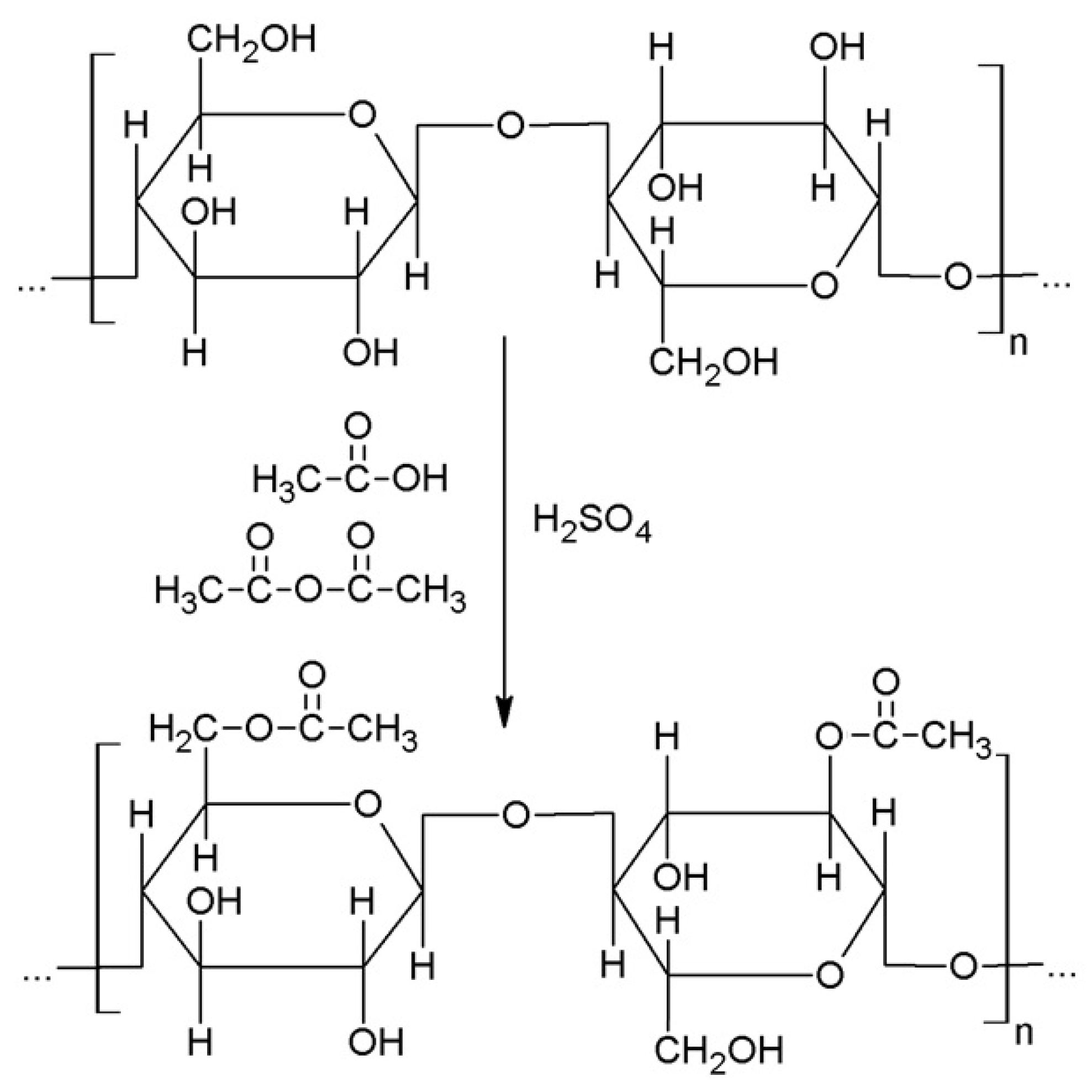
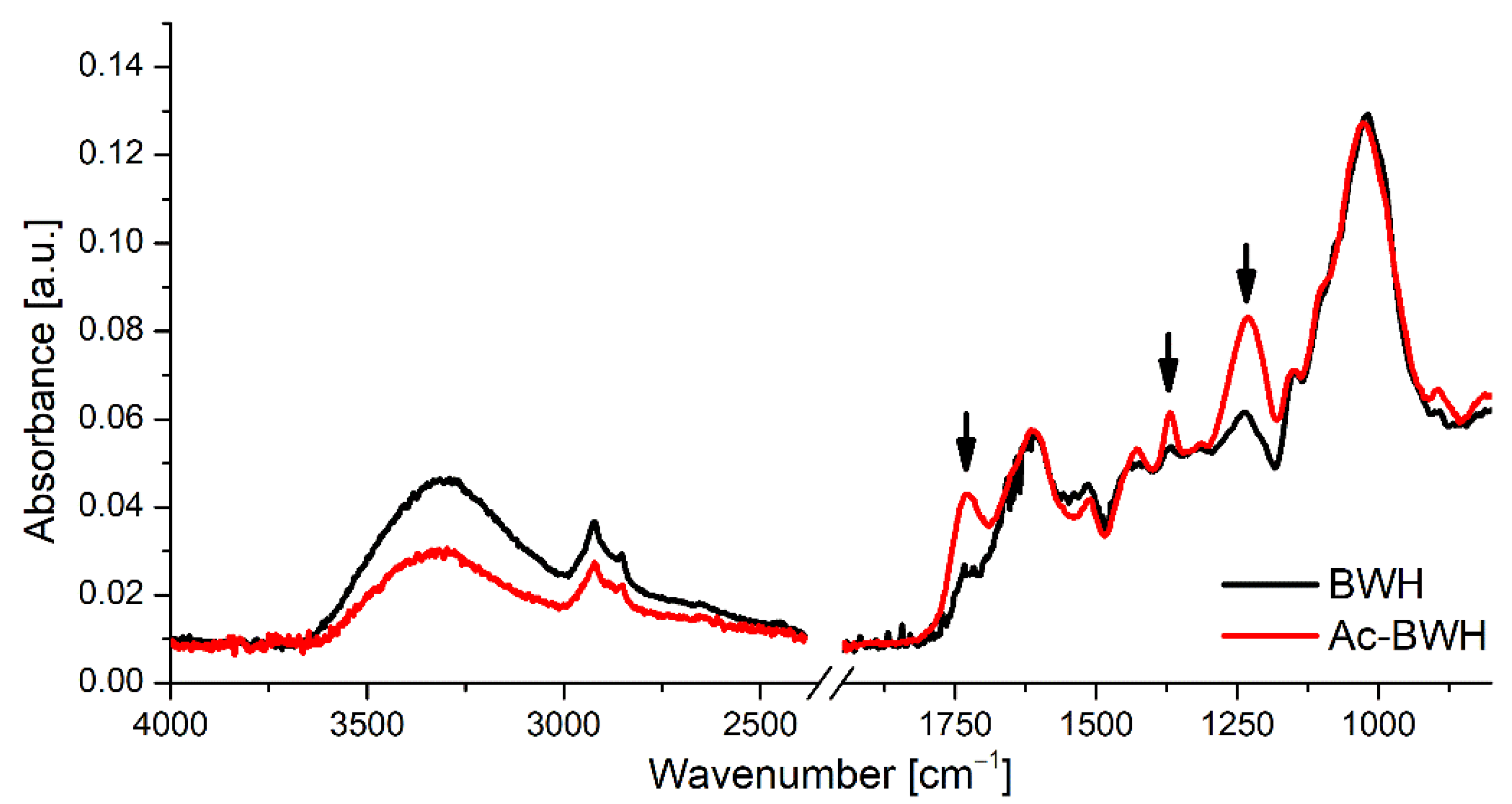
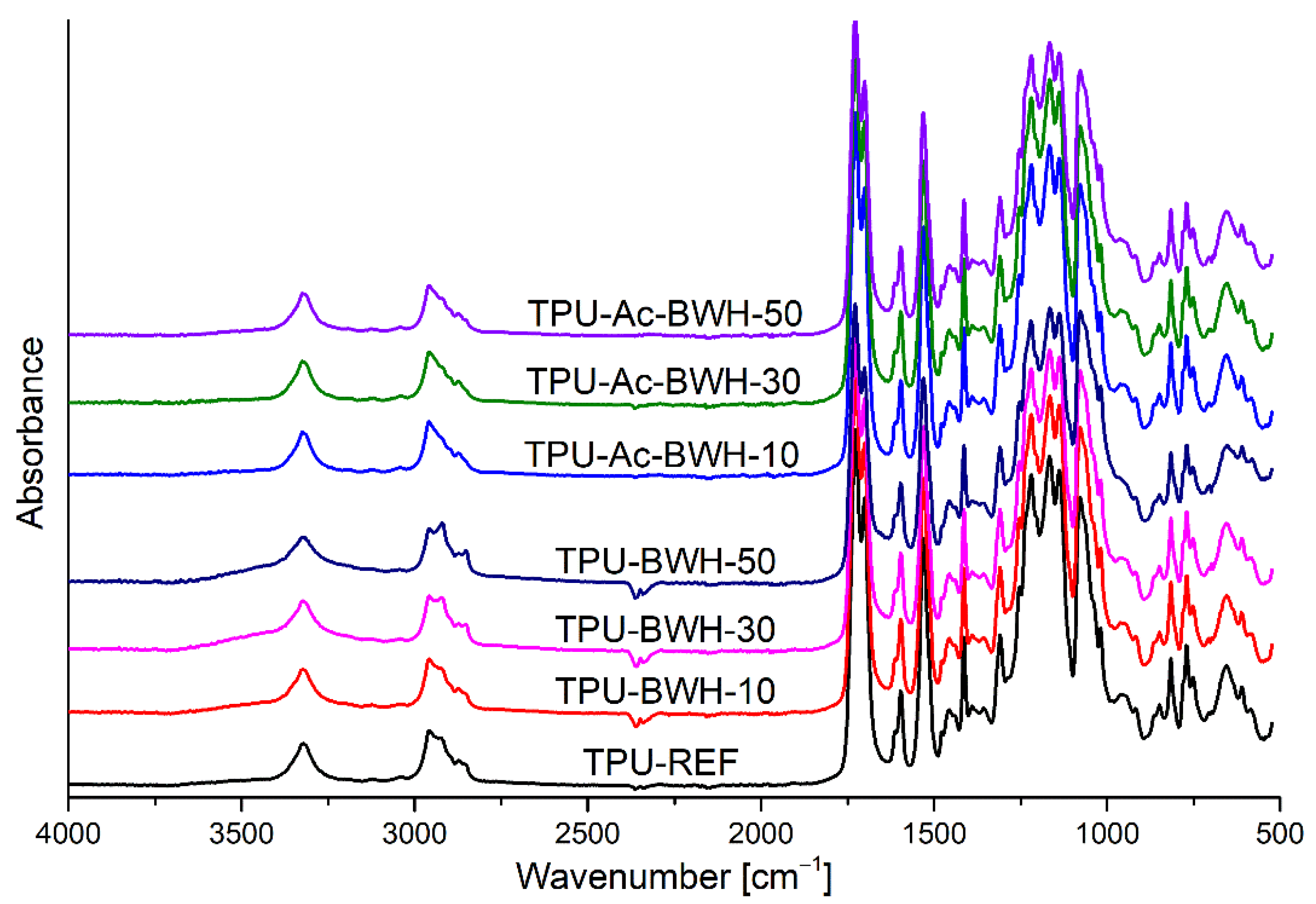
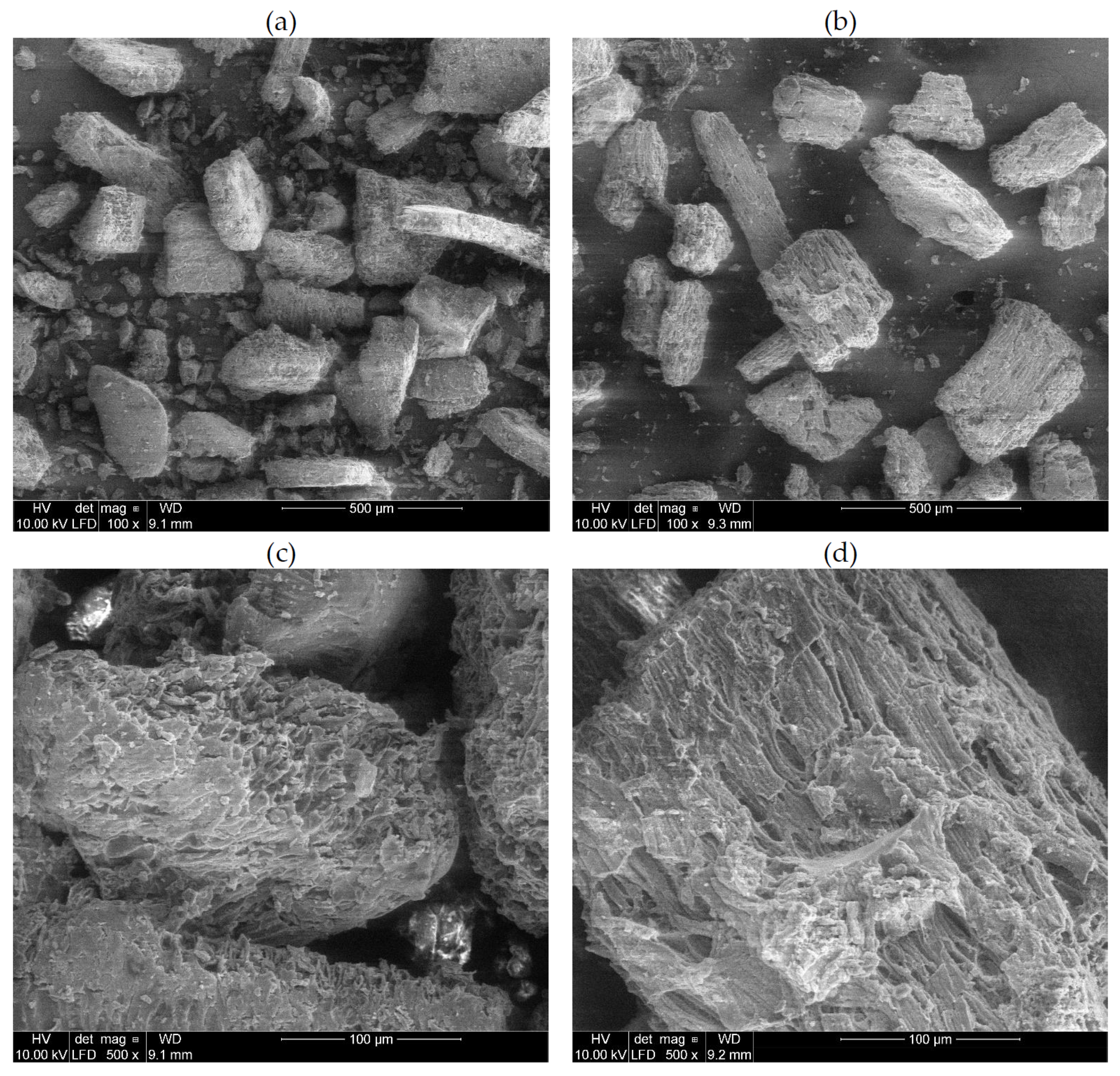
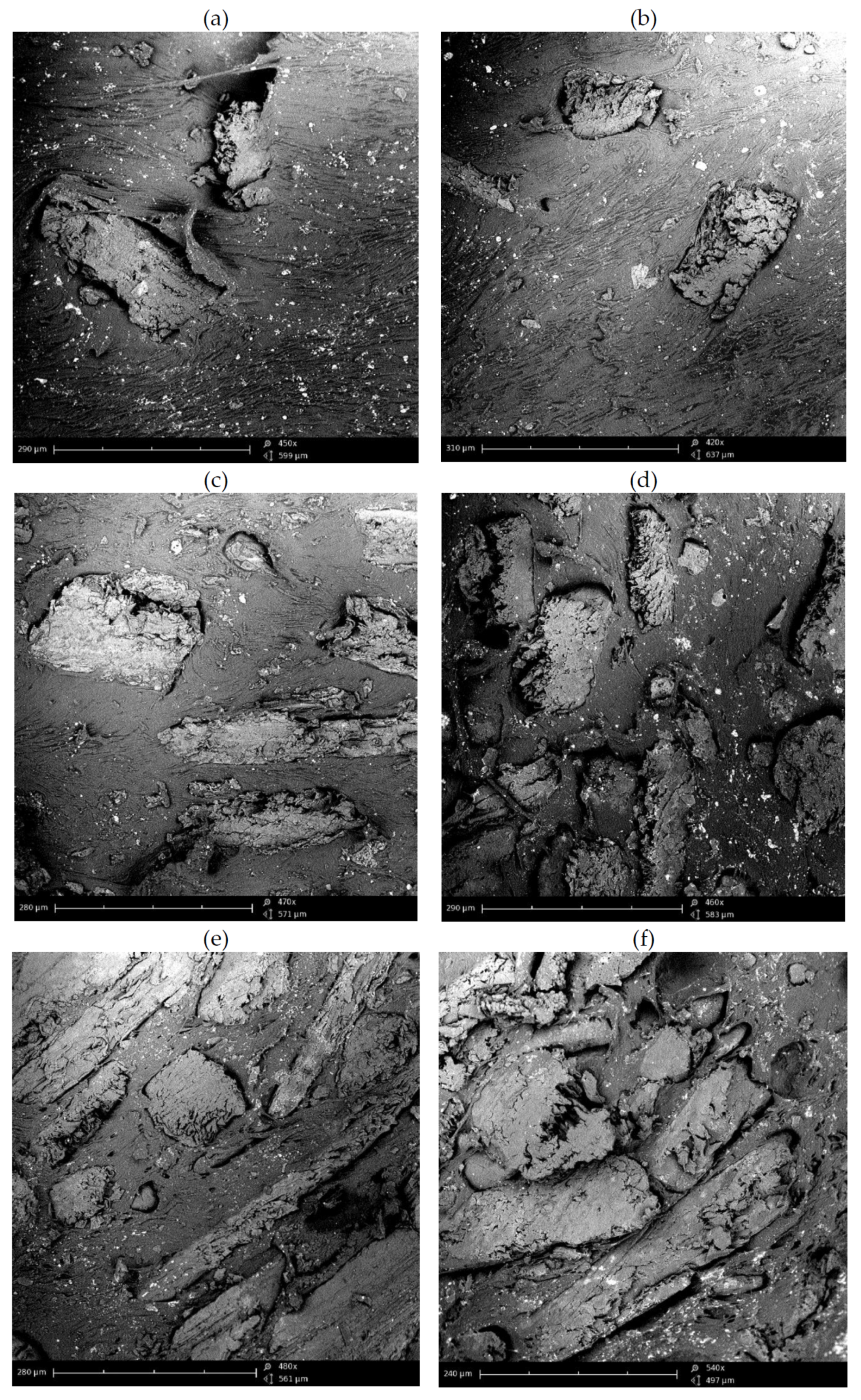
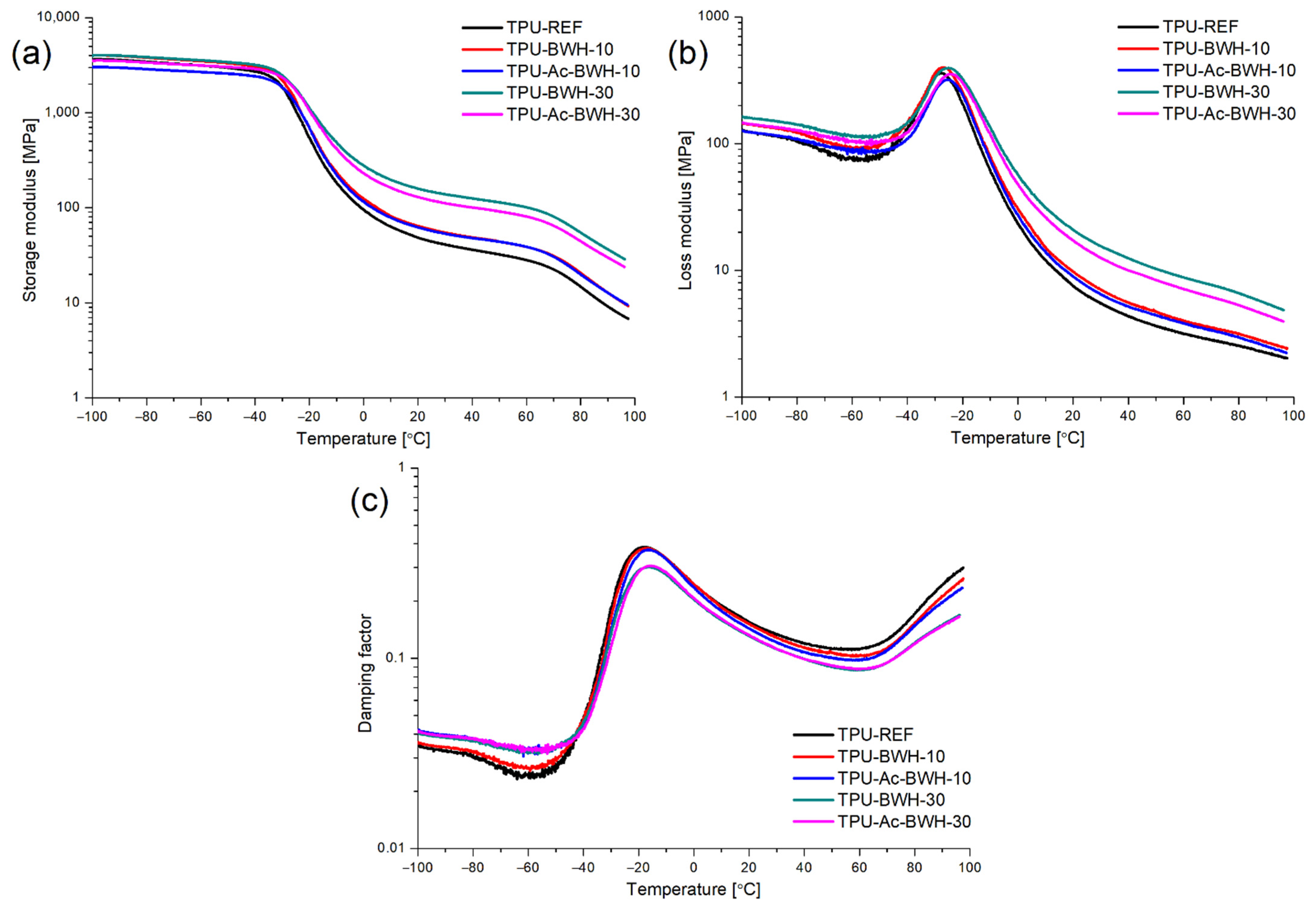
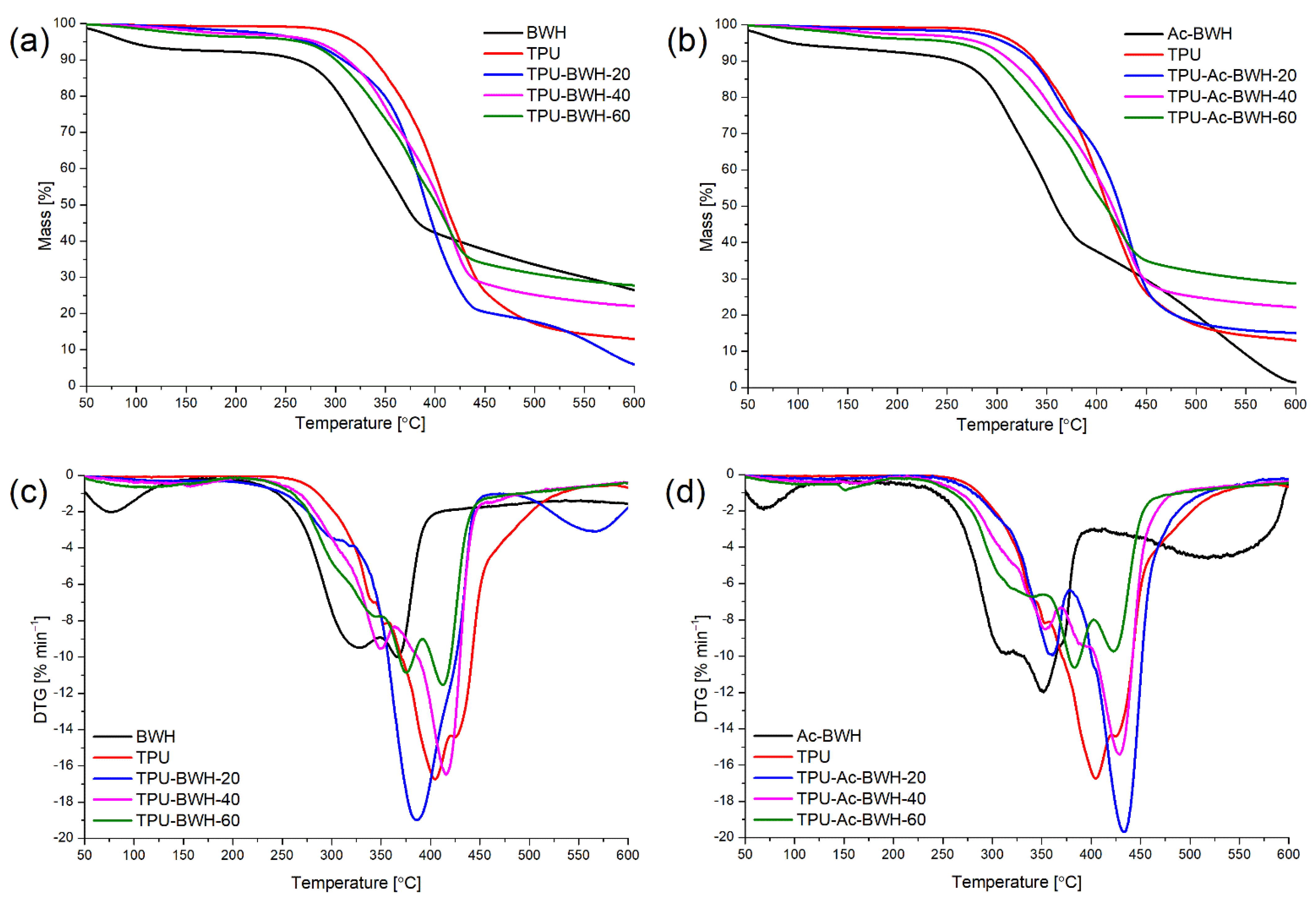
| Material Code | Storage Modulus at −100 °C, MPa | Storage Modulus at +21 °C, MPa | Maximum Value of Loss Modulus, MPa | Temperature at Which E″ Reached Maximum Value, °C |
|---|---|---|---|---|
| TPU-REF | 3647 | 47 | 360 | −28.0 |
| TPU-BWH-10 | 4025 | 63 | 399 | −26.7 |
| TPU-BWH-30 | 3012 | 156 | 394 | −25.1 |
| TPU-Ac-BWH-10 | 4024 | 61 | 319 | −25.5 |
| TPU-Ac-BWH-30 | 3541 | 127 | 353 | −24.2 |
| Material Code | Glass Transition Temperature of Soft Segments Tg SS, °C | Tan Delta at Tg |
|---|---|---|
| TPU-REF | −17.9 | 0.3480 |
| TPU-BWH-10 | −16.9 | 0.3784 |
| TPU-BWH-30 | −16.2 | 0.3010 |
| TPU-Ac-BWH-10 | −16.6 | 0.3710 |
| TPU-Ac-BWH-30 | −15.5 | 0.3055 |
| Material Code | Td 5%, °C | Td 10%, °C | Td 50%, °C | Td max, °C | Char Yield at 600 °C, % |
|---|---|---|---|---|---|
| BWH | 91.8 | 260.0 | 370.4 | 327.8/366.4 | 26.5 |
| BWH-Ac | 93.3 | 259.1 | 358.0 | 313.6/352.0 | 1.4 |
| TPU-REF | 318.5 | 338.7 | 410.8 | 404.7 | 13.0 |
| TPU-BWH-20 | 272.5 | 307.3 | 391.4 | 386.4 | 6.0 |
| TPU-BWH-40 | 280.2 | 311.8 | 405.5 | 349.2 | 22.1 |
| TPU-BWH-60 | 264.3 | 300.1 | 401.8 | 375.8 | 27.8 |
| TPU-Ac-BWH-20 | 309.1 | 335.7 | 423.2 | 361.3 | 15.0 |
| TPU-Ac-BWH-40 | 283.9 | 314.1 | 415.9 | 354.5 | 22.1 |
| TPU-Ac-BWH-60 | 258.7 | 300.4 | 408.9 | 383.4 | 28.6 |
| Material Code | Tensile Strength, MPa | Elongation at Break, % | Hardness, ShA |
|---|---|---|---|
| TPU-REF | 8.5 ± 0.3 | 404.1 ± 6.7 | 26.3 ± 1.0 |
| TPU-BWH-10 | 6.7 ± 0.4 | 107.2 ± 2.6 | 30.2 ± 1.0 |
| TPU-BWH-20 | 8.1 ± 0.3 | 62.9 ± 3.2 | 36.7 ± 0.9 |
| TPU-BWH-30 | 9.0 ± 0.1 | 65.1 ± 14.0 | 38.7 ± 1.7 |
| TPU-BWH-40 | 10.5 ± 0.2 | 50.3 ± 8.3 | 45.4 ± 2.3 |
| TPU-BWH-50 | 9.8 ± 1.3 | 19.3 ± 6.7 | 49.5 ± 1.6 |
| TPU-BWH-60 | 10.9 ± 0.5 | 14.8 ± 0.5 | 54.6 ± 1.2 |
| TPU-Ac-BWH-10 | 7.5 ± 0.1 | 288.4 ± 45.9 | 30.3 ± 1.2 |
| TPU-Ac-BWH-20 | 6.4 ± 0.1 | 107.6 ± 22.2 | 34.8 ± 1.0 |
| TPU-Ac-BWH-30 | 7.8 ± 0.3 | 50.9 ± 11.4 | 39.3 ± 1.1 |
| TPU-Ac-BWH-40 | 8.4 ± 0.1 | 41.5 ± 3.0 | 44.1 ± 0.9 |
| TPU-Ac-BWH-50 | 8.0 ± 0.3 | 15.9 ± 3.0 | 49.0 ± 0.7 |
| TPU-Ac-BWH-60 | 10.4 ± 0.7 | 14.7 ± 0.9 | 56.8 ± 1.1 |
| Material Code | Density, g cm−3 | Volume Fraction of Filler (Vf), % | Polymer Matrix–Filler Interaction Parameter (B) |
|---|---|---|---|
| TPU-REF | 1.224 ± 0.001 | - | - |
| TPU-BWH-10 | 1.234 ± 0.004 | 0.091 | 3.89 (R2 = 0.99) |
| TPU-BWH-20 | 1.245 ± 0.002 | 0.184 | |
| TPU-BWH-30 | 1.262 ± 0.001 | 0.279 | |
| TPU-BWH-40 | 1.278 ± 0.004 | 0.377 | |
| TPU-BWH-50 | 1.289 ± 0.005 | 0.475 | |
| TPU-BWH-60 | 1.301 ± 0.003 | 0.576 | |
| TPU-Ac-BWH-10 | 1.235 ± 0.003 | 0.092 | 3.67 (R2 = 0.98) |
| TPU-Ac-BWH-20 | 1.246 ± 0.003 | 0.186 | |
| TPU-Ac-BWH-30 | 1.258 ± 0.003 | 0.282 | |
| TPU-Ac-BWH-40 | 1.269 ± 0.004 | 0.379 | |
| TPU-Ac-BWH-50 | 1.280 ± 0.001 | 0.478 | |
| TPU-Ac-BWH-60 | 1.294 ± 0.004 | 0.580 |
Publisher’s Note: MDPI stays neutral with regard to jurisdictional claims in published maps and institutional affiliations. |
© 2022 by the authors. Licensee MDPI, Basel, Switzerland. This article is an open access article distributed under the terms and conditions of the Creative Commons Attribution (CC BY) license (https://creativecommons.org/licenses/by/4.0/).
Share and Cite
Włoch, M.; Landowska, P. Preparation and Properties of Thermoplastic Polyurethane Composites Filled with Powdered Buckwheat Husks. Materials 2022, 15, 356. https://doi.org/10.3390/ma15010356
Włoch M, Landowska P. Preparation and Properties of Thermoplastic Polyurethane Composites Filled with Powdered Buckwheat Husks. Materials. 2022; 15(1):356. https://doi.org/10.3390/ma15010356
Chicago/Turabian StyleWłoch, Marcin, and Paulina Landowska. 2022. "Preparation and Properties of Thermoplastic Polyurethane Composites Filled with Powdered Buckwheat Husks" Materials 15, no. 1: 356. https://doi.org/10.3390/ma15010356
APA StyleWłoch, M., & Landowska, P. (2022). Preparation and Properties of Thermoplastic Polyurethane Composites Filled with Powdered Buckwheat Husks. Materials, 15(1), 356. https://doi.org/10.3390/ma15010356






